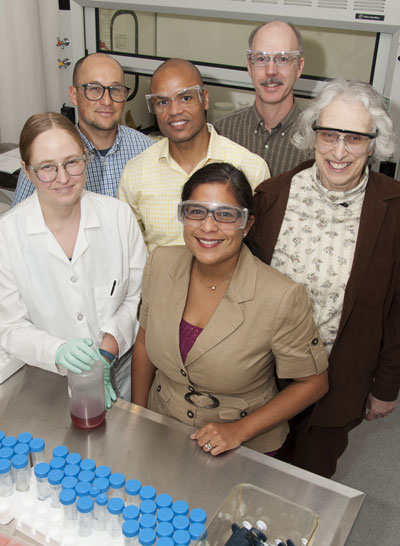| Oct 24, 2013 |
FDA working to understand nanotechnology's impact on drug quality, safety, or effectiveness
|
|
(Nanowerk News) Nanotechnology is a new and exciting field that offers scientists the opportunity to control matter at very small dimensions, opening many possibilities for making all kinds of new products. This technology operates on an incredibly small scale that measures things in units called nanometers. One nanometer is one billionth of a meter. It’s hard to even imagine how small that is, but here’s one way to do it: A human hair is about 100,000 nanometers wide.
|
|
Wow, that’s small! But nanotechnology promises big things! There are already many products made using materials at the nanoscale, including new kinds of clothing, packaging materials, and light-weight, but strong, building materials.
|
|
Why are we at FDA’s Center for Drug Evaluation and Research (CDER) writing about it? Because medical products can also be made using materials at the nanoscale. In fact some are already available, including certain sunscreens, in which the nanomaterials are used to provide UV protection while remaining transparent on the skin, and in drugs to treat cancer, including Doxil and Abraxane. Use of nanomaterials can enhance delivery of drugs to their biological target or help scientists customize them for a particular type of patient.
|
 |
| Some members of the Nanotechnology Working Group in the CDER labs where characterization of gold nanoparticles is underway. Left to right, front row: Katherine Tyner, Ph.D. Office of Clinical Pharmacology; Celia N. Cruz, Ph.D. Office of New Drug Quality Assessment; middle row: Olen Stephens, Ph.D. Office of New Drug Quality Assessment: Don Henry, Office of Pharmaceutical Science; Abigail Jacobs, Ph.D. Office of New Drugs; back: Paul Brown, Ph.D. Office of New Drugs.
|
|
Materials at the nanoscale can have different chemical, physical, or biological properties compared to their conventionally-scaled counterparts. Scientists can use these features to enhance the properties or the quality of a drug. But because such properties can affect the quality, safety, or effectiveness of a drug, FDA is studying these issues related the use of this powerful new technology in medical products.
|
|
Recently, to help us better understand the potential impact nanotechnology could have on a drug’s quality, safety, or effectiveness, CDER’s Nanotechnology Risk Assessment Working Group (Nano Group) finalized a series of risk assessment and risk management exercises to identify potential risks associated with a drug product that contains nanomaterials. A key goal was to determine if our current regulatory processes are adequate to identify any potential risks and reduce those risks.
|
|
The CDER Nano Group consisted of a multidisciplinary team of scientists that could provide a complete evaluation of the use of nanomaterials in the types of drugs regulated in the Center. We first performed a thorough risk assessment of all stages in the lifecycle of a drug containing nanomaterials to capture any real or perceived hazards related to the nanomaterials. To complete the exercise, we evaluated the common ways a person could be exposed to nanomaterial in a drug product — swallowing a drug, having it injected, applied to the skin, or inhaled. In addition, we evaluated unintentional and accidental exposure.
|
|
Once all the potential risks were identified, we undertook a risk management exercise to examine the regulatory process we use to evaluate drugs. We then considered whether the identified potential risks in the first exercise could be sufficiently managed by the existing review processes we use to help protect patients from harm.
|
|
Our risk management exercise determined that our current regulatory review processes indeed can adequately protect the public from potential risks associated with the use of nanomaterials in drug products. We also identified areas that could benefit from improvement. These areas include increased nanotechnology regulatory science research and up-to-date training of the review staff who evaluate marketing applications for drug products developed using nanomaterials. FDA does not make a categorical judgment that nanotechnology is intrinsically safe or harmful. Rather, for nanotechnology-derived and conventionally-manufactured products alike, FDA considers the characteristics of the finished product and, as applicable, its safety, effectiveness, or other product attributes.
|
|
Historically, FDA has successfully adapted to novel technologies, and the robust review process we use will continue to capture the potential risks associated with this new technology. To share the findings of the nanotechnology risk assessment and management exercises, in January 2014, FDA will co-sponsor a workshop with the US Pharmacopeia, the International Society for Pharmaceutical Engineering, the American Association for Pharmaceutical Scientists, and the Society of Toxicology to review and share experience gained during the development and review of medical products containing nanomaterials. With these and other activities, FDA will continue to work to ensure that safe, effective drugs are available to the American public.
|

